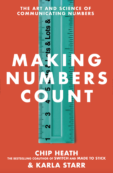Steven Strogatz, an applied math prof at Cornell, has started a series on the NYT site to re-teach basic math from an adult perspective, with the goal to show “why it’s so enthralling.”
I love the second installment, which explores the way that using rocks in place of digits (i.e., six rocks rather than the number “6”) can provide unexpected insight on seemingly tough problems:
For example, instead of adding just two odd numbers together, suppose we add all the consecutive odd numbers, starting from 1:
1 + 3 = 4
1 + 3 + 5 = 9
1 + 3 + 5 + 7 = 16
1 + 3 + 5 + 7 + 9 = 25
The sums above, remarkably, always turn out to be perfect squares. (We saw 4 and 9 in the square patterns discussed earlier, and 16 = 4 × 4, and 25 = 5 × 5.) A quick check shows that this rule keeps working for larger and larger odd numbers; it apparently holds all the way out to infinity. But what possible connection could there be between odd numbers, with their ungainly appendages, and the classically symmetrical numbers that form squares? By arranging our rocks in the right way, we can make this surprising link seem obvious — the hallmark of an elegant proof.
The key is to recognize that odd numbers can make L-shapes, with their protuberances cast off into the corner. And when you stack successive L-shapes together, you get a square!




